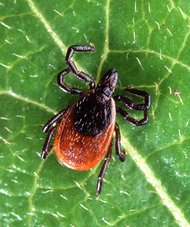Lyme disease
Lyme disease or Lyme borreliosis is an infectious tick-borne disease, caused by the Borrelia spirochete, a gram-negative microorganism. more...
Lyme disease is so named because it is generally believed to have first been observed in and around Old Lyme and Lyme, Connecticut in 1975. Before 1975, elements of Borrelia infection were also known as "tick-borne meningopolyneuritis", Garin-Bujadoux syndrome, Bannwarth syndrome or sheep tick fever. It is transmitted to humans by the bite of infected ticks.
History
The disease was first documented as a skin rash in Europe in 1883. Over the years, researchers there identified additional features of the disease, including an unidentified pathogen, its response to penicillin, the role of the Ixodes tick (wood tick) as its vector, and symptoms that included not only the rash but additional ones that affected the nervous system.
Researchers in the US had been aware of tick infections since the early 1900s. For example, an infection called tick relapsing fever was reported in 1905, and the wood tick, which carries an agent that causes Rocky Mountain spotted fever, was identified soon after. However, the full syndrome now known as Lyme disease, was not identified until a cluster of cases thought to be juvenile rheumatoid arthritis occurred in three towns in southeastern Connecticut, in the United States. Two of these towns, Lyme and Old Lyme, gave the disease its popular name.
In 1982 a novel spirochete was isolated and cultured from the midgut of Ixodes ticks, and subsequently from patients with Lyme disease. The infecting agent was first identified by Jorge Benach, and soon after isolated by Willy Burgdorfer, a scientist at the National Institutes of Health who specialized in the study of spirochete microorganisms. The spirochete was named Borrelia burgdorferi in his honor. Burgdorfer was the partner in the successful effort to culture the spirochete, along with Alan Barbour.
Microbiology
The disease is caused by the parasite Borrelia, which has well over three hundred known genomic strains but is usually cultured as Borrelia burgdorferi, Borrelia afzelii or Borellia garinii. Different Borrelia strains are predominant in Europe and North America.
The disease has been found to be transmitted to humans by the bite of infected Ixodes ticks. Not all ticks carry or can transmit this particular disease. The disease may also, in a few cases, be transmitted by mosquitoes, fleas or blackflies. However, other Borrelia strains (e.g. B. garinii) are probably transmitted this way.
Other tick-borne infections may be transmitted simultaneously with Lyme, including Bartonella, Babesiosis, Ehrlichiosis, and Rickettsia.
Borrelia burgdorferi resembles other spirochetes in that it is a highly specialized, motile, two-membrane, spiral-shaped bacterium which lives primarily as an extracellular pathogen. One of the most striking features of Borrelia burgdorferi as compared with other eubacteria is its unusual genome, which includes a linear chromosome approximately one megabase in size and numerous linear and circular plasmids.
Read more at Wikipedia.org



